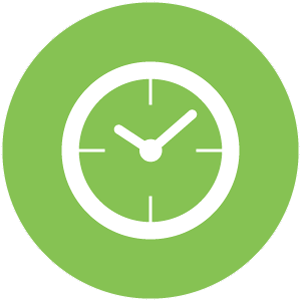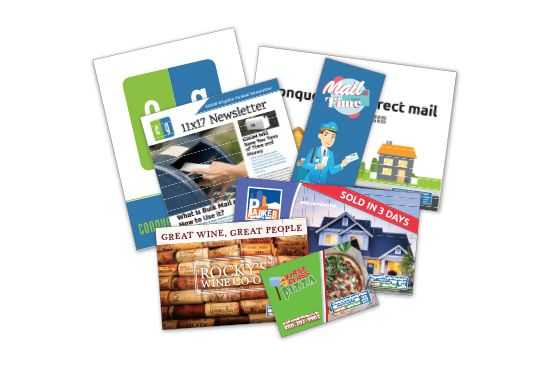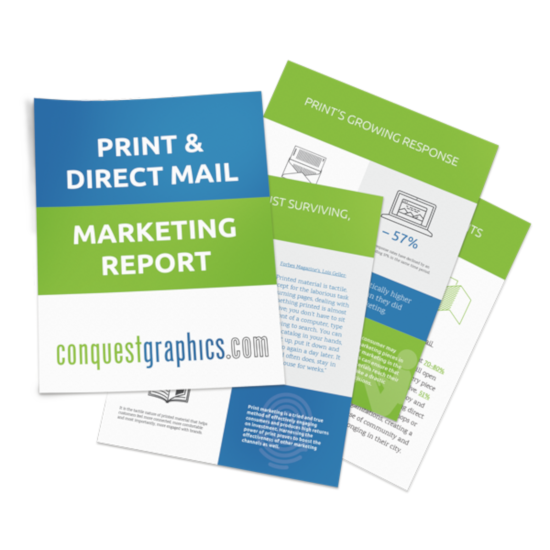
Brochures, pamphlets, and flyers are one of the cheapest printed products available and they are extremely effective marketing materials.
While these materials are very affordable, when it comes to brochure printing with commercial printers, there are several factors that most strongly influence the price.
These key factors have varying degrees of influence on the end cost of brochures, but simply taking a closer look at these factors can give you a better understanding of why these job details affect pricing as well as how you can keep the cost of brochure printing within your budget.
To better understand the various cost-affecting parts of brochure printing, we’ve broken them down into categories below so you can plan better for your brochure and flyer printing projects.

Quantity
It seems logical that if you order more of something, the price will go up. While this is often true for the overall printing cost, the price per printed material will actually decrease significantly resulting in each brochure being much cheaper. And in some cases, the total cost being cheaper.
This is due to the way jobs are laid out on press sheets and how certain numbers of them are often more difficult or require special treatment to work.
For example, suppose you’re printing 450 two-sided 5.5” x 8.5” brochures. Printing exactly 450 of them results in each brochure costing anywhere from $0.20-0.48. Simply adding 50 so you’re printing an even 500 brochures results in each brochure costing between $0.15-0.30. That is around a $40.00 decrease in the total difference for just adding 50 more brochures to your print order.
This price drop is due to the fact that printing those 50 extra brochures results in an easier laying out process for the production team when they’re laying out the brochure job on press sheets.
Printing lower quantities may result in the production team spending slightly more time trying to figure out another print job that is in their press queue that can fit on the same press sheet so they can save paper and time by working on both at the same time.
Simply increasing your brochure quantity decreases the price because it’s easier to have press sheets filled with just your job than it is to have to find other compatible press jobs that would fit alongside your lower volume job.
Pro Tip #1 for Printing Cheap Brochures:
Keep your brochure quantities at nicely spaced intervals (50, 100, 250, 500, etc.) when printing as this will save the print production team time and resources, which will be reflected in the brochure price and ultimately save you money on brochure printing costs.

Paper
The type of paper you choose to print on has a very heavy influence on the cost of brochure printing.
Most printers have a set of cost-effective house stocks that they recommend using when you choose to print with them. For example, we have a “Conquest Preferred” stock that is the default option value when configuring your order on our product pages.
Some of the preferred stocks for brochure printing include 100# gloss and velvet text, 80# gloss and velvet text, 100# gloss and velvet cover, 80# gloss and velvet cover and a 14pt C2S gloss cover. While all of these paper options will be much cheaper than printing a brochure with a specialty paper, they all have a different influence on the cost of your brochures.
For example, a 100# Gloss Text weight paper is cheaper than 100# Gloss Cover.
Because house stocks are such popular paper types, printers order them in bulk and therefore they are the most cost-effective options for your brochure project. Also, because they are more common, it’s easier for your brochures to print alongside other projects that require the same type of paper, which allows the production team to move projects along the press much faster. This is all reflected in the price of your brochures.
Specialty papers typically require printers to specially order them since they’re rarely used. If a special order is required, it may require extra time and it will cost the printer more, which translates to the final brochure printing cost.
Pro Tip #2 for Printing Cheap Brochures:
Typically choosing a specialty paper not offered in your printer's default options won’t make a huge difference in the brochure itself and will ultimately increase the price of your brochures. So, we recommend always taking advantage of your printer’s house stocks to ensure the price of your brochures are within your budget.
If you’re interested in saving money by taking advantage of your printer's house stocks, but aren’t sure what option is right for your brochure project, feel free to take advantage of our free sample booklet by clicking here so you can see and feel the most popular paper options before committing.

Turnaround Time
Depending on how quickly you need your print order, there will be varying prices associated with different turnaround times. Generally speaking, the sooner you need your brochure printing order, the steeper the price will be.
This is due to the benefits associated with longer turnarounds for commercial printers. If you allow a printer a turnaround time of 6-9 days rather than a 2-day turnaround, they will have more time to receive similar jobs that they can print alongside yours on the press sheet before cutting and folding, therefore saving themselves paper, time, and resources. This is all translated to the overall cost of printing brochures.
Some of Conquest Graphics’ products, including some brochure options, are “Quick-Ship” products, meaning they have a turnaround time of just one or two days. This is usually because they’re smaller items that can be printed in bulk more easily on our digital press.
Just like ordering anything else online, it costs more to get it to you more quickly.
Pro Tip #3 for Printing Cheap Brochures:
To help keep the price of your brochures on the lower end, make sure to plan and order your brochures as early as possible. This will give you the opportunity to choose a longer turnaround time which will save you a lot of money.

Ink
When it comes to matching colors and getting projects to match their digital renderings more perfectly, it can take special types of ink to get exactly the colors a customer wants.
For example, if a customer wants an exact color in their brochure project, they may specify that they want to use a certain Pantone Matching System (or PMS) color value. Ordering special PMS colors of ink can become quite costly, so getting exactly that color for the customer can add a significant cost to their project.
Usually, only international brands or brands that are highly focused on maintaining consistency across all their printed media will have exact PMS requirements for their jobs.
In most cases, cyan, magenta, yellow and key (or black) or the CMYK color system is the best and most cost-effective for rendering precise colors.
Pro Tip #4 for Printing Cheap Brochures:
We recommend sticking to the CMYK color system in your printing job as this will result in the overall brochure cost being significantly lower. If your project requires PMS colors, and you have a strict budget to maintain, be sure to plan ahead so you can save extra money by extending your turnaround time.

Size
The size of your brochure has a large impact on how a commercial printer prints your project on press sheets and will determine how many press sheets are needed to print your brochures.
The larger each individual brochure ends up being, the more press sheets it will require, which translates to higher costs associated with printing it.
Sticking with smaller brochures like 5.5” x 11”, 8.5” x 11”, or 9” x 12” brochures, is the most cost-effective choice to make when printing your brochures as it will allow your printer to piece your project together with other projects, saving them time and paper.
Pro Tip #5 for Printing Cheap Brochures:
While choosing brochures of a smaller size will result in cheaper brochures, your brochures may gain better results and a higher ROI if they are larger. If this is the case, to save money on your large brochures, we recommend sticking with your printer's house stocks as well as planning ahead so you can choose a longer turnaround time.

Folding
The final factor that influences the cost of your brochure project is folding.
Ultimately, if you choose no folding it will be cheaper, if you choose a simple fold like a trifold, z-fold, or half-fold, the brochure printing price will slightly increase. And if you choose a more complex brochure fold, like a closed gate fold or half/half fold, the printing cost will increase even more.
No matter how you decide to fold your brochure, the increase in price won’t be drastic as long as you choose a standard fold offered by your printer. If you choose a specialty fold, however, the price can increase significantly as specific folding directions may require a special machine or hand folding.
The folding process can also add additional time to your turnaround. If you need a brochure, pamphlet, or flyer folded, you can expect at least one additional day needed on your turnaround for the folding to be completed. This also depends on the quantity of brochures you need folded.
Pro Tip #6 for Printing Cheap Brochures:
Get a good understanding of the different types of brochures. This will help you in deciding the right type of fold that works best for your brochure message. For example, closed gate brochures and half/half brochures may work best with your message, but they are more expensive than a trifold or z-fold brochure.
So, How Much Does it Cost to Print Brochures?
In the end, all these factors combine to determine the printing costs for your brochures.
In addition, when considering your budget, you also need to keep in mind your brochure advertising costs. Will you be handing your brochures out or using them as leave behinds? Or will they be a part of a direct mail campaign? Depending on your marketing strategy, it will help you determine the best options to choose when printing your brochures to ensure you meet your goals and budget.
The end cost to print brochures will depend on all the specifications outlined above, which could be anywhere from $30 to $30,000. Additional shipping costs can add a little as well, but in the end, the best way to save on your brochure printing project is to use the tips in each section above to keep the costs down.
 Get Started on Your Brochure Order
Get Started on Your Brochure Order
How Much Does it Cost to Print Brochures?
When it comes to pricing brochures, there are a number of costs that have varying amounts of influence on the final price to the customer. Check out this blog to get a better understanding of how small differences in printing specifications can save you huge amounts of money.
By Conquest Graphics









